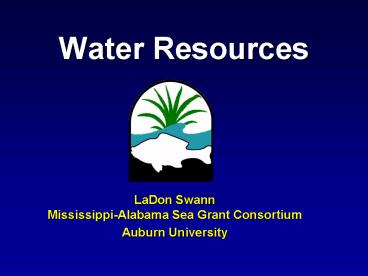Water Resources - PowerPoint PPT Presentation
1 / 36
Title:
Water Resources
Description:
Inadequate water quality causes more losses than any other ... carboniferous rock. Removal. intense aeration. buffers. calcium carbonate. sodium bicarbonate ... – PowerPoint PPT presentation
Number of Views:42
Avg rating:3.0/5.0
Title: Water Resources
1
Water Resources
- LaDon SwannMississippi-Alabama Sea Grant
Consortium - Auburn University
2
Water Resources
- Water sources
- Water quality
- Water quantity
Inadequate water quality causes more losses than
any other problem!
3
Water Sources
- Springs
- Wells
- Rivers, lakes and streams
- Surface
- Groundwater
- Municipal
4
Springs
- Advantages
- constant temperature
- few or no predators
- no pathogens
- Disadvantages
- pumping cost if not gravity fed
5
Wells
- Types
- pumped
- artesian
- Advantages
- no predators
- no pathogens
- Disadvantages
- high dissolved gasses
- like N2 and CO2
- low O2
6
Rivers, Lakes and Streams
- Advantages
- large volumes
- inexpensive
- Disadvantages
- contaminates
- predators
- excessive nutrients
7
Surface
- Advantages
- inexpensive
- Disadvantages
- contaminates
- draughts or floods
- 5-7 acre watershed
- per surface acre
- of water
8
Groundwater
- Advantages
- inexpensive
- few/no predators
- Disadvantages
- hard to drain
- buildup of organics
- removal of fish
9
Municipal
- Advantages
- very high quality
- no predators
- no pathogens
- Disadvantages
- disinfectants
- chlorine
- chloramines
- expensive
10
Water Quality
- Daily or weekly tests
- Semi-annually or annually
11
Daily or Weekly
- Dissolved oxygen
- Nitrogen compounds
- ammonia
- nitrite
- nitrates
- pH
- Alkalinity
- Hardness
- Carbon Dioxide
- Temperature
- Hydrogen sulfide
- Total suspended solids
- Chlorine
12
Dissolved Oxygen
- Importance
- highest cause of mortality
- Solubility
- variables
- temperature (-)
- elevation (-)
- salinity (-)
- Safe levels
- greater than 5 mg/L
13
Nitrogen Compounds
- Types
- dissolved gas
- ammonia
- ionized
- un-ionized
- nitrite
- nitrate
14
Ammonia
- Ammonia (NH3) results from the breakdown of fish
feed, and waste - Two forms
- Ionized (NH4)
- Unionized (NH3).
- Unionized ammonia concentration is a function of
pH and temperature - Chronic exposure of 0.06 mg/L in the unionized
form is toxic to warm water species such as
catfish
15
Nitrite
- Nitrite (NO2-) is the intermediate product in the
breakdown of ammonia to nitrate (nitrification) - Nitrite levels greater than 0.60 mg/L or 10 times
higher than the toxic threshold for unionized
ammonia is toxic to fish
16
Nitrate
- Nitrate (NO3-) is the final breakdown product in
the oxidation of ammonia - Nitrate is relatively nontoxic to fish at
concentrations up to 3.0 mg/L
17
Nitrification
- Requires 3 moles oxygen to convert one mole of
ammonia to nitrate - Nitrification is an acidifying reaction
18
Relationships
19
pH
- Measure of the hydrogen
- ion concentration
- 1-14 scale
- less than 7 acidic
- greater than 7 basic
- Safe range
- 6.5-9
20
Carbon Dioxide
CH2O (food) O2 ? CO2 H2O
- Sources
- bi-product of respiration of
- fish and phytoplankton
- wells
- carboniferous rock
- Removal
- intense aeration
- buffers
- calcium carbonate
- sodium bicarbonate
21
Alkalinity
- Alkalinity is the capacity of water to buffer
against wide pH swings - Acceptable range 40-400 mg/L
Bicarbonate CO2 H2O ? H HCO3-
Carbonate HCO3- ? H CO3-
Effects of calcite lime
CaCO3 CO2 H2O ? Ca2 2HCO3-
Dolomite CaMg(CO3)2 yields 4HCO3-
22
Alkalinity
Bicarbonate pK1 6.3 Carbonate pK2 10.4
Relationship Between pH and Various Carbonate
Ions.
23
Hardness
- Hardness if the measure of divalent cations
- calcium
- magnesium
- Hardness is used as an indicator of alkalinity
but hardness is not a measure of alkalinity - magnesium or calcium sulfate increases hardness
but has no affect on alkalinity - Recommended hardness levels
24
Hydrogen Sulfide
- Source
- well water
- inadequate filtration
- shift from aerobic to
- anaerobic breakdown
- of wastes
- Removal
- intense aeration
25
Total Solids
- Types
- suspended
- settleable
- Sources
- runoff
- uneaten food
- feces
- Safe levels
- less than 1,000 mg/L
- Removal
- filtration
- settling chambers
26
Chlorine
- Disinfectant
- municipal water
- to clean tanks and equipment
- Safe levels
- less than 0.3 mg/L
- Removal
- intense aeration
- sodium thiosulfate
- 1 mg/L for every mg/L chlorine
- sunlight
27
Temperature
- Effects
- metabolic rate doubles
- for every 18oF increase
- Influences spawning
- Influences growth
- Fish Categories
- warmwater
- coolwater
- coldwater
28
Warmwater Species
- Food fish species
- channel catfish
- tilapia
29
Coolwater Species
- Food fish species
- hybrid striped bass
- yellow perch
- largemouth bass
30
Coldwater Species
- Food fish species
- rainbow trout
- Atlantic salmon
- coho salmon
31
Dissolved Gasses
- Problem gasses
- nitrogen
- maintain less than 110
- CO2
- maintain less than 10 mg/L
- Problem sources
- wells and springs
- leaky pipes
32
Semi-annual or Annual
- Cadmium
- Copper
- Iron
- Ferrous
- Ferric
- Lead
- Manganese
- Mercury
- Phosphorus
- Toxins
- Zinc
- Ozone
33
Water Quantity
- Ponds
- Raceways
- Cages
- Recirculating aquaculture systems
34
Ponds
- Minimum requirement
- 26 gal./min. per surface acre
- Rational
- to fill spawning ponds
- to replace evaporation
- to refill ponds after
- harvesting
35
Raceways
- Minimum requirement
- 500 gal./min.
- Rational
- constant water
- exchange
- high densities
- 15-20 lbs./gal./min.
36
Recirculating Aquaculture Systems
- Minimum requirement
- varies depending on
- size of system
- enough water for 10
- exchange per day
- Rational
- needed to backflush filters
- during harvesting
- emergencies































